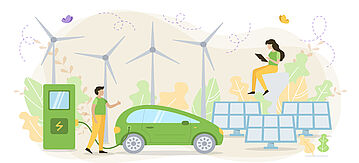Advanced materials make it possible to generate, store and save energy, but can also pose new challenges for chemical safety and circular economy.
The German Environment Agency (UBA) commissioned the Federal Institute for Materials Research and Testing (Bundesanstalt für Materialforschung, BAM) to look at which advanced materials (AdMas) are already helping to drive forward the energy transition today and which ones could be used in future. The report defines AdMas as materials intentionally designed with specific structures or material properties in mind for their area of application. For the study, scientific publications were reviewed to identify materials that are already being used or tested today to generate, store and save energy. Ten of these materials are outlined in more detail, as they were identified as particularly relevant for a variety of reasons: perovskite, quantum dots, Copper Indium Gallium Selenide (CIGS), aerogels, iridium oxide, metal-organic frameworks (MOFs), hard carbon, MXenes, graphenes and related 2D materials (GR2M) and Carbon Nanotubes (CNTs). In addition to their benefits for the energy transition, the study also outlines the challenges these materials can pose for resource use and the protection of human health and the environment.
Benefits and (un)known challenges
The report found that advanced materials hold enormous potential for bringing about the energy transition. Some of these materials are already in use, while others are still being researched. Laboratory tests have shown that combining certain advanced materials can achieve optimal thermal insulation, maximum efficiency levels, excellent conductivity and positive synergy effects. At the same time, however, little information is available on the risks the materials pose to human health and the environment. In some areas, their application requires the use of harmful substances, or their production is extremely raw material- and energy-intensive. There are already foreseeable challenges when it comes to recycling advanced materials: for example, the size and shape of some AdMas are similar to pathogenic fibres, which can also be produced when materials containing CNTs are exposed to mechanical stresses during recycling. Crushing CNT-containing composite materials for recycling can generate highly conductive, fine dust that clogs machines. If harmful raw materials are encapsulated so that they can be used safely (such as lead-containing perovskites), they are more difficult to recover.
Report provides an initial overview
For advanced materials to drive forward the energy transition while ensuring safety and sustainability, more in-depth studies are needed. The report provides an initial overview based on a review of relevant literature.
The final report entitled "Advanced materials for the energy transition Study to survey the state of knowledge and technology on the application of advanced materials in the various technologies for the production and storage of renewable energies" by Xenia Knigge, Jörg Radnik, Federal Institute for Materials Research and Testing, Berlin (PDF; English only) was published as UBA TEXTE 83/2025.
Update Date: 08.09.2025

